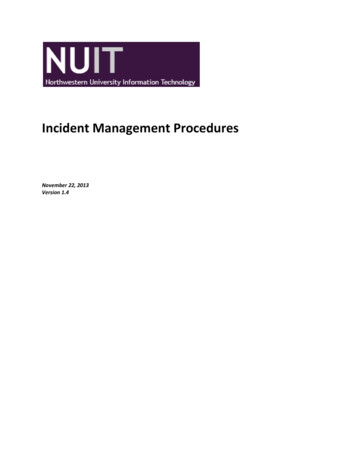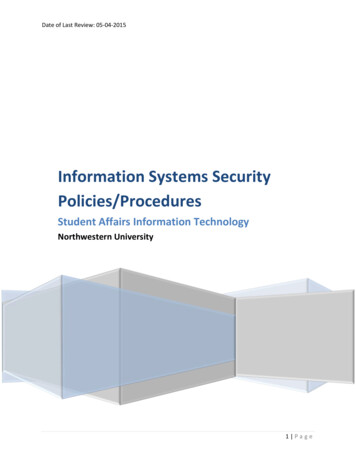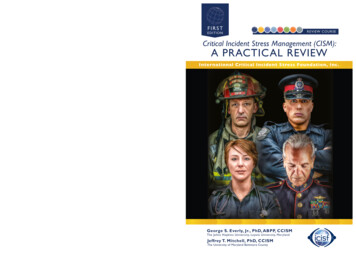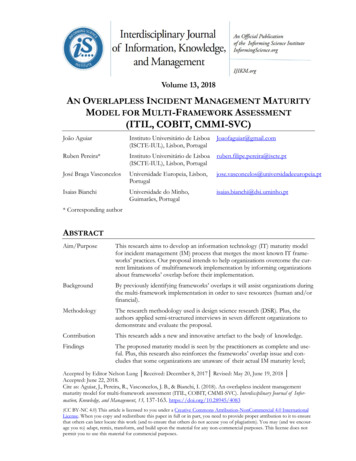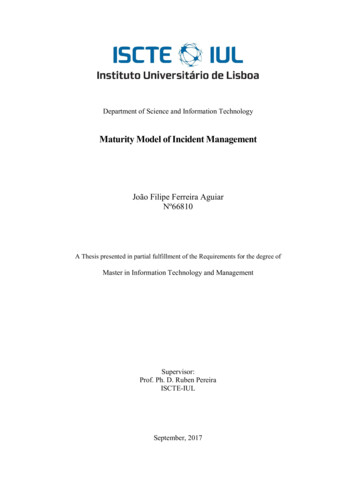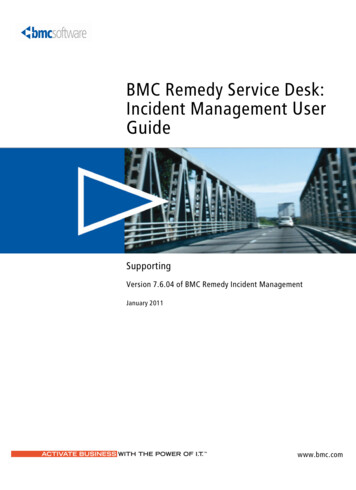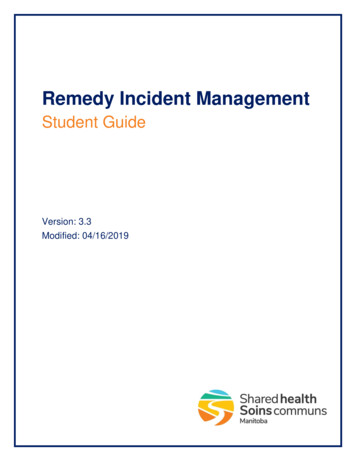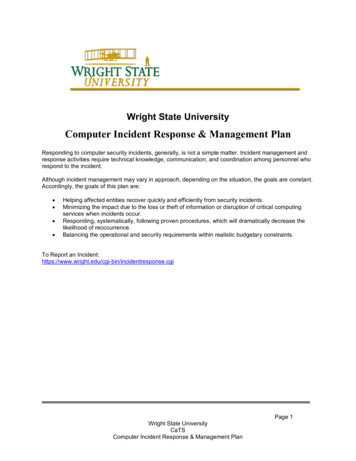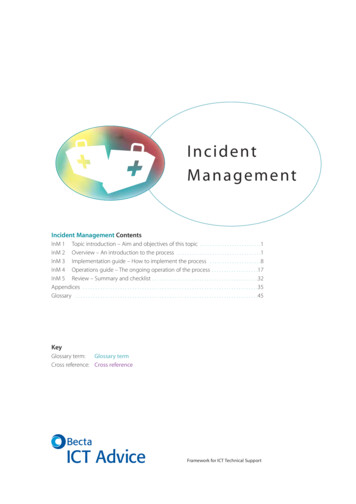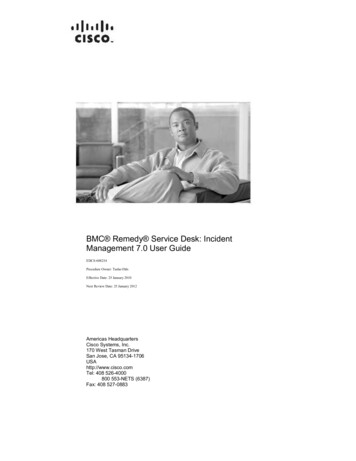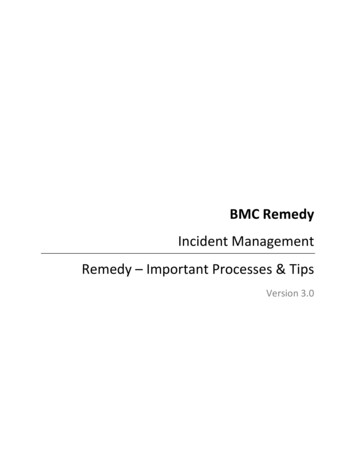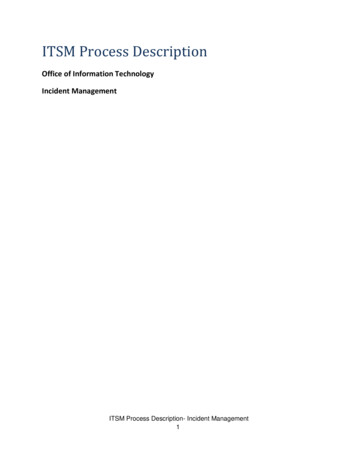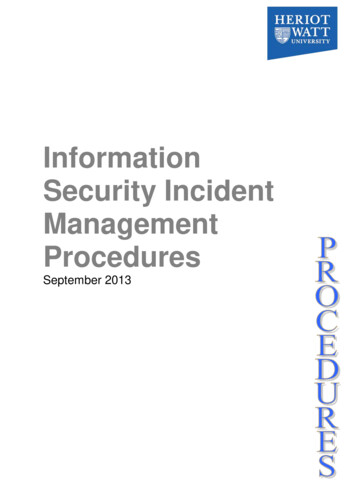
Transcription
InformationSecurity IncidentManagementProceduresSeptember 2013
HERIOT-WATT UNIVERSITYPROCEDURESTO SUPPORT INFORMATION SECURITY INCIDENT MANAGEMENT POLICYCONTENTSSectionPage1 Introduction2 How to report an information security incident33.13.23.33.445678Appendix 1Appendix 2Appendix 3Appendix 433How to manage the response to an incidentWho needs to be involved?Assessing the risks and actions to be takenWho else needs to be informed?Reviewing the incidentMonitoring and managing risksRelated policies, procedures and further referenceFurther help and adviceDefinitionsProcedure version and history4555677789Information security incident reportInformation security incident management checklistInformation Security Incident escalation processInformation Security Incident response flowchart10111920
Heriot-Watt University Information Security Incident Management Procedures1.INTRODUCTIONThese procedures underpin and should be read in conjunction with the HeriotWatt University Information Security Incident Management Policy.If you need to report an incident, please read sections two, seven andAppendix 1If you receive an information security incident report or need to respond to anincident, please read from section three onwards.2.HOW TO REPORT AN INFORMATION SECURITY INCIDENTPlease report any actual, suspected or potential breach of informationsecurity promptly as follows:In office hours (UK time 9 a.m. – 5 p.m. Monday –Friday)Breaches of IT or Information Security:Contact the IT Help desk by one of the following methods Telephone 44 (0) 131 451 4045Telephone from University phones on the Edinburgh campus:extension 4045 Email: IThelp@hw.ac.ukBreaches of physical security, stolen, lost and found IT andcommunications equipment and portable devicesContact the Duty Security Supervisor in the Security Control Room at theEdinburgh campus by one of the following methods: Telephone 44 (0) 131 451 3500 Telephone from University phones on the Edinburgh campus:Extensions 3500 or 2222(emergency number) Use red telephones in the shared/public areas at the Edinburghcampus to connect directly to Security Control RoomOut of hours: ALL information security incidentsContact the Duty Security Supervisor in the Security Control Room at theEdinburgh campus.Where possible use the incident reporting form (Appendix 1). This willenable the relevant details of the incident to be recorded consistently andcommunicated on a need to know basis to relevant staff so that prompt andappropriate action can be taken to resolve the incident.Version 2: August 2013Author: Ann JonesURL3
Heriot-Watt University Information Security Incident Management Procedures33.1HOW TO MANAGE THE RESPONSE TO AN INFORMATION SECURITYINCIDENTWho needs to be involved?On receiving the incident report, the senior officer on duty in the sectionreceiving the report will contact the relevant Head of School, Institute orService and one or more of the following Lead Officers as appropriate.Use the Information Security Incident response flowchart in Appendix 4as a guide.If a report is received out outside office hours, the senior officer on duty shouldfollow the Information Security Incident escalation process inAppendix 3.Lead Officer for Breaches of IT security: Director of Information Services ordesignate (or School Computing Officer), liaising with Head of School, Instituteor Service affected or their designateExamples: Virus or other security attack on IT equipment, systems or networks Breach of IT and Communications Facilities Acceptable Use PolicyIf the investigation of the incident requires access to a user’s IT account e.g.ina case of suspected downloading of illegal material, this must be escalated tothe Secretary of the University for approval.Lead Officer for breaches of information security: Information SecurityOfficer (Head of Heritage and Information Governance) liaising with HeadSchool, Institute or Service affected or their designate and the Head of Riskand Audit ManagementExamples: loss or unauthorised disclosure of medium or high risk confidential information personal data information and records of operational, legal or evidential value to theUniversityLead Officer for breaches of physical security: loss or theft of devices orequipment: Security and Operations Manager or designate liaising with Headof School, Institute or Service affected or their designate Security andOperations Manager will, where appropriate, inform the policeExamples: lost or stolen laptop, attempted break in to secure server or records storeVersion 2: August 2013Author: Ann JonesURL4
Heriot-Watt University Information Security Incident Management Procedures3.2Assessing the risks and actions to be takenThe Lead Officer should use the guidance in section 2.2 and 2.3 of theIncident Management Checklist in Appendix 2 and the Information SecurityIncident escalation process in Appendix 3 to decide whether the incident is ofLow Criticality (GREEN) which can managed within normal operatingproceduresMedium Criticality (AMBER): a serious adverse incident, requiringassistance from designated Officers or specialist support teams outside thebusiness unit. Most incidents will fall into this category.High Criticality (RED) a major incident requiring significant Universityresource beyond normal operating procedures, requiring escalation to theMajor Incident PlanThis will help determine: Who should take the lead in containment and recovery from the incident Who should take the lead in investigating the incident Who else needs to assist What resources they need What can be done to recover any losses What can be done to limit the damage caused by the incident Whether the incident needs to be reported to the policeThe lead officer will inform the other responsible officers, listed below, andliaise with them and the relevant members of their teams as appropriate toresolve the incident. Director of Information ServicesInformation Security OfficerSecurity and Operations ManagerHead of Risk and Audit ManagementThe Lead Officer will liaise with the other responsible officers andinformation/systems owners to consider the risk factors in section 2.3 of theincident management checklist and take the actions necessary to manage theincident and mitigate its impact.3.3Who else needs to be informed?The Information Security Officer will liaise with the other ResponsibleOfficers and the Director of Governance and Legal Services to determinewhether it is necessary to notify the breach to others beyond the reportingchain of command within the University.If the incident is a breach of physical security, such as the theft of a laptop,the Security and Operations Manager or designate will call the police promptlyas part of the standard operating procedure.Version 2: August 2013Author: Ann JonesURL5
Heriot-Watt University Information Security Incident Management ProceduresIf an incident involves other alleged criminal acts such as suspecteddownloading of illegal material, the Secretary of the University or designatewill ask the police to investigate.If the breach involves the loss of a University mobile phone or tablet theSecurity and Operations Manager or designate will inform ProcurementServices who will notify the service provider and arrange for a replacement.If the breach involves the loss or disclosure of personal data:The Information Security Officer and Director of Governance and LegalServices will consider whether it is necessary toInform the individuals concernedE.g. If individuals need to act on this information to mitigate risks, for exampleby cancelling a credit card or changing a passwordNotify the UK Information Commissioner of the breachE.g. if a large volume of personal data has been lost and there is a real risk ofindividuals suffering some harm e.g. an unencrypted laptop containingthe names, addresses, dates of birth and national insurance numbersof 1000 staff personal data of a small number of individuals if there is significant riskof the individuals suffering substantial harm e.g. paper financial recordsof 50 individuals; an unencrypted memory stick containing highlysensitive personal data about one vulnerable individualIf the breach involves the loss or disclosure of other medium or high riskconfidential information such as research data received or processed underconditions of confidentiality it may be necessary to notify the supplier of theinformation and other external stakeholders e.g. a regulatory body, grantfunderIn each case the notification should include as a minimum a description of how and when the breach occurred what information was involved what action has been taken to respond to the risks posed by the breachThe Information Security Officer and the Director of Governance and LegalServices will identify any significant risks that need to be escalated as a matterof urgency to the Risk Management Strategy Group and addressed though theUniversity's Risk Management Plan and Disaster Recovery Plan.3.4Reviewing the incidentThe Responsible Officers will meet to review the incident, ensure that allappropriate actions have been taken to mitigate its impact and identify furtheraction needed to reduce the risk of a future breach of this kind.The Lead Officer will use the incident checklist and reporting tool to producean incident report setting out:Version 2: August 2013Author: Ann JonesURL6
Heriot-Watt University Information Security Incident Management Procedures 4.A summary of the incidentHow and why the incident occurredActions taken to resolve the incident and manage its impactImpact of the incident (Operational, financial, legal, liability,reputational)Risks of other adverse consequences of the incident (Operational,financial, legal, liability, reputational)Any further remedial actions required to mitigate the impact of thebreachActions recommended to prevent a repetition of the security breachResource implications or adverse impacts, if any, of these actionsMONITORING AND MANAGING RISKSThe Information Security Officer will receive reports of all information securityincidents and use these to compile a central record of incidents. TheInformation Security Officer will report on these to the Information SecurityGroup and thence to the Secretary of the University at least on a quarterlybasis in order to identify lessons to be learned, patterns of incidents andevidence of weakness and exposures that need to be addressed.For each serious or major incident the Information Security Group will lead areview to consider and report to the Secretary of the University What action needs to be taken to reduce the risk of future breaches andminimise their impact?Whether policies procedures or reporting lines need to be improved toincrease the effectiveness of the response to the breach?Are there weak points in security controls that need to bestrengthened?Are staff and users of services aware of their responsibilities forinformation security and adequately trained?Is additional investment required to reduce exposure and if so what arethe resource implications?The Information Security Officer will liaise with the relevant Head of School,Institute or Service and the Head of Risk and Audit management to update thelocal or corporate risk register/s.5.RELATED POLICIES AND PROCEDURES AND FURTHER REFERENCEThese procedures form part of the University Information Security PolicyFramework and its underpinning policies, procedures and guidance which arepublished on the University website sion 2: August 2013Author: Ann JonesURL7
Heriot-Watt University Information Security Incident Management Procedures6.FURTHER HELP AND ADVICEFor further information and advice about these procedures and any aspect ofinformation security, contactAnn JonesHead of Heritage and Information Governance ,0131 451 3219Email a.e.jones@hw.ac.ukor foi@hw.ac.uk7.DEFINITIONSInformationThe definition of information includes, but is notconfined to, paper and electronic documents andrecords, email, voicemail, still and moving imagesand sound recordings, the spoken word, datastored on computers or tapes, transmitted acrossnetworks, printed out or written on paper, carried onportable devices, sent by post, courier or fax,posted onto intranet or internet sites orcommunicated using social media.ConfidentialinformationThe definition of confidential information can besummarised as: Any personal information that would causedamage or distress to individuals if disclosedwithout their consent. Any other Information that would prejudicethe University's or another party’s interests ifit were disclosed without authorisation.A more detailed definition can be found in thePolicy for secure use of confidential information onportable mediaInformation securityincidentAny event that has the potential to affect theconfidentiality, integrity or availability of Universityinformation in any format. Examples of informationsecurity incidents can include but are not limited to: Version 2: August 2013Author: Ann JonesURLThe disclosure of confidential information tounauthorised individualsLoss or theft of paper records, data orequipment e.g. laptops, smartphones ormemory sticks, on which data is stored8
Heriot-Watt University Information Security Incident Management Procedures Information SecurityManagement System8.Inappropriate access controls allowingunauthorised use of informationSuspected breach of the University IT andCommunications Acceptable Use PolicyAttempts to gain unauthorised access tocomputer systems, e, g hackingRecords altered or deleted withoutauthorisation by the data “owner”Virus or other security attack on ITequipment systems or networks“Blagging” offence where information isobtained by deceptionBreaches of physical security e.g. forcing ofdoors or windows into secure room or filingcabinet containing confidential informationleft unlocked in accessible areaLeaving IT eq
Heriot-Watt University Information Security Incident Management Procedures Version 2: August 2013 Author: Ann Jones URL 6 If an incident involves other alleged criminal acts such as suspected downloading of illegal material, the Secretary of the University or designate will ask the police to File Size: 417KBPage Count: 20
